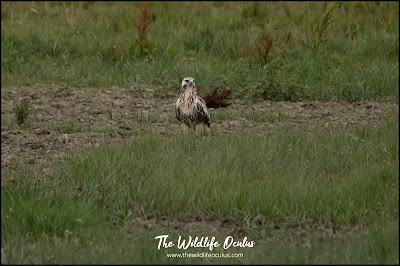A small reserve attracts lots of birds
I have to to admit for a small reserve Goldcliff Lagoons punches well above its weight in terms of the amount and variety of bird species it attracts. Week after week there is always something to watch when I visit and at almost any time of day.
There has been a bit of a summer lull. July is often a period when birds have bred, fledged and stopped being so active. Some species have left our shores completely as they have migrated to breed in the the far North. As the month progresses though things start to change. The "Autumn" migration begins. I know its not autumn proper yet but many birds by the end of July are starting to migrate back from their breeding grounds. Many species including a lot of waders start heading towards the coastal wetlands. Some are on passage and stop to fuel up on the plentiful invertebrates before flying south or some are early winter migrants and will stay in the UK for the winter.
Birdwatchers need to be on the look out as there will be juvenile first year birds passing through and sometimes if we are lucky the odd rare migrant.
The first notable visitors to Goldcliff Lagoons I noticed in relation to Autumn Passage have been the Black Headed Gulls. At this time of year they usually start to congregate in large numbers. Its been good to see a few Mediterranean Gulls mixed in with them.
More recently Pied and Yellow Wagtails have been putting in an appearance and the hirundines are arriving in larger numbers again. All of these species are no doubt enjoying the large number of insects that are attracted to the lagoons and the mud.
Over the last week or so two juvenile Spoonbills have been visiting the lagoons. I watched them Thursday have a little dispute with Goldcliffs other exotic species - the "resident" Glossy Ibis.
Flossy has now been frequenting the lagoons since at least the 26th of January 2019 when I first photographed it.
Yesterday I spent the morning at the reserve accompanied by two of my regular birding companions - Nev Davies and John Lawton.
Despite it being a "low tide" visit the reserve was busy with birds. "Bosprey" the Buzzard that is occasionally confused with an Osprey landed on the edge of Monks Lagoon.
 |
| "Bosprey" |
There are a couple of "whitish" Buzzards that frequent the reserve but I have not seen one of these birds for sometime so it was good to see it quite close up.
Common Sandpipers are now starting to turn up quite regularly. Probably stopping over whilst on migration. If you carefully scan the lagoons you be lucky and spot a Wood or Green Sandpiper. These birds are closely related and you may need to refer to your bird book to get the identification right.
We were fortunate to see a Green Sandpiper on Priors Lagoon.
 |
| Green Sandpiper |
Priors which is a freshwater lagoon is now covered in a green algae. I have been told by Kevin Dupe the reserve manager that the algae is in fact Blanket Weed and the bloom is likely to have been caused by the the hot weather and high nutrients.
It does not appear to be deterring the birds. I have never seen so many Coots on it and there is now Little Grebes turning up on a regular basis. Yesterday Priors was the busiest lagoon by far. Three hundred or more Black Tailed Godwits were roosting at the far end. The two Spoonbills had been seen with them early on. The lagoon was starting to look like "Swan Lake" as eight Mute Swans and a Black Swan were floating around.
I saw a flash of blue and heard the piping of a Kingfisher as it hurtled along the edge of the reed bed. Overhead the sky was full of Sand martins,Swallows and House Martins.
 |
| A flash of blue |
The star of the show was probably "Flossy" the Glossy Ibis again. It showed well all morning on Priors. It would alternately feed on Priors for a while and then fly over the sea wall and feed on the foreshores mud.
 |
| Glossy Ibis on Priors |
 |
| Glossy Ibis on the foreshore mud |
A Peregrine caused some chaos amongst a large flock of lapwings that had been roosting on Priors. I initially mistook it for a Hobby but on reviewing my pictures it was definitely a Peregrine. It kind of explains why the Lapwings went up very high in the sky in reaction to appearance of the falcon.
One species which appeared a little down on numbers were the Dunlins. I only saw 8 of them. I suspect more would turn up at High Tide. Both Common and Little Ringed Plovers were feeding on the mud patches throughout the reserve. Late in the morning a Greenshank made an appearance on Priors and roosted in with the Godwits.
 |
| Greenshank in background, Black Tailed Godwits and Grey Herons. |
It was a great days bird watching and yet again Goldcliff Lagoons did not disappoint.


Comments
Post a Comment